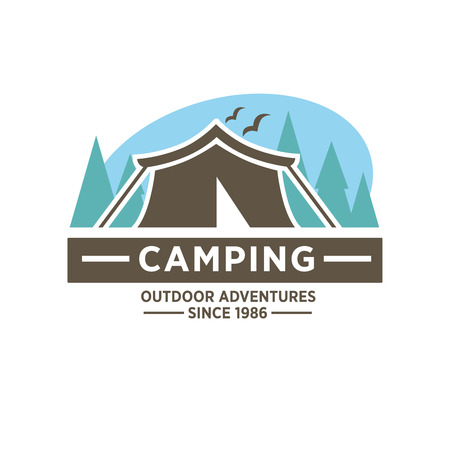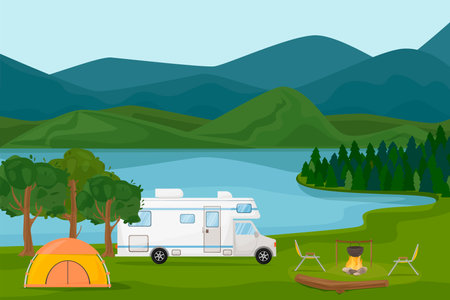1. Planning Your Summer Camping Adventure
Summer is the perfect season to explore the great outdoors, and planning your camping trip across the U.S. starts with choosing the right time, destination, and style of camping that fits your travel goals. Whether youre dreaming of mountain hikes, lakeside relaxation, or starry desert nights, a little planning goes a long way in making your adventure unforgettable.
Pick the Right Time
The U.S. has diverse climates, so timing matters. In general, June through August are prime months for summer camping, but some regions can be too hot or crowded during peak season. Heres a quick guide:
| Region | Best Time to Camp | Why |
|---|---|---|
| Pacific Northwest | July – September | Mild temps, low rain |
| Southwest (Arizona, Utah) | May – Early June | Avoid extreme heat |
| Northeast & Midwest | June – August | Warm weather and full park access |
| Southeast (Florida, Georgia) | March – May | Avoid hurricane season and humidity |
| Rocky Mountains | Late June – Early September | Snow-free trails and alpine views |
Select Your Destination Type
The U.S. offers every kind of landscape—from beaches and forests to deserts and mountains. Think about what kind of scenery you want to wake up to each morning.
- National Parks: Great for iconic landscapes and established campgrounds (e.g., Yellowstone, Yosemite).
- State Parks: Often less crowded with great amenities.
- Bureau of Land Management (BLM) Land: Ideal for dispersed camping and more solitude.
- Private Campgrounds: Good for families looking for extra comforts like showers and Wi-Fi.
Choose Your Camping Style
Your comfort level and how much gear you own will influence your style of camping. Here’s a breakdown to help you decide:
| Camping Style | Description | Best For |
|---|---|---|
| Car Camping | You drive to your campsite; everythings nearby. | Beginners, families, casual campers |
| Backpacking | You hike in with all your gear on your back. | Adventure seekers, hikers, minimalists |
| RV or Van Camping | You camp in a vehicle with sleeping/living space. | Road trippers, comfort lovers, long trips |
| Glamping | “Glamorous camping” with luxury tents or cabins. | Couples, non-campers wanting nature + comfort |
Pro Tip:
If youre new to camping or traveling with kids, start with car camping at a state park close to home. It’s a great way to get used to the experience without being too far off-grid.
Don’t Forget Permits & Reservations!
Many popular campsites—especially in national parks—require reservations months in advance. Check websites like Recreation.gov or individual state park systems for booking details. Also look into permits if youre heading into backcountry areas or planning a fire in certain regions.
Your Next Step:
Create a rough itinerary based on your available dates, preferred region, and desired camping style. From there, you can start building out your packing list and researching specific campgrounds or trails!
2. Must-Visit Summer Camping Destinations Across the U.S.
Summer is the perfect season to explore the great outdoors, and the United States offers a wide variety of camping destinations that cater to every type of camper. Whether youre looking for iconic national parks, peaceful state park hideaways, or campgrounds that are fun for the whole family, theres something for everyone from coast to coast.
🏞️ Iconic National Parks
National parks are top picks for summer camping thanks to their breathtaking landscapes and well-maintained facilities. Here are a few must-visit parks:
| National Park | Location | Highlights |
|---|---|---|
| Yellowstone National Park | Wyoming, Montana, Idaho | Geysers, wildlife, and stunning mountain views |
| Yosemite National Park | California | Granite cliffs, waterfalls, and giant sequoias |
| Great Smoky Mountains National Park | Tennessee & North Carolina | Misty mountains, wildflowers, and hiking trails |
| Zion National Park | Utah | Canyon hikes and dramatic desert scenery |
| Acadia National Park | Maine | Coastal views, forest trails, and rocky beaches |
🌲 Hidden Gems in State Parks
If you’re looking to avoid big crowds but still want a memorable outdoor experience, state parks offer incredible beauty with fewer visitors. Here are some underrated gems worth checking out:
| State Park | Location | Why Visit? |
|---|---|---|
| Custer State Park | South Dakota | Bison herds, scenic drives, and beautiful lakeside camping |
| Letchworth State Park | New York | “The Grand Canyon of the East” with waterfalls and gorges |
| Silver Falls State Park | Oregon | Towering waterfalls along lush hiking trails |
| Palo Duro Canyon State Park | Texas | The second-largest canyon in the U.S., great for hiking and biking |
| Douthat State Park | Virginia | A peaceful retreat with fishing, boating, and mountain views |
🏕️ Family-Friendly Campgrounds You’ll Love
If youre traveling with kids or just want an easier camping setup, these campgrounds offer amenities like restrooms, playgrounds, ranger programs, and even cabins:
- Kampgrounds of America (KOA): A nationwide network of family-friendly campgrounds with amenities like pools, game rooms, and organized activities.
- Sugarloaf Key / Key West KOA Holiday (Florida): Tropical island vibes with oceanfront campsites.
- Lake George RV Park (New York): A resort-style campground with a water park and shuttle service to nearby attractions.
- Cherokee / Great Smokies KOA (North Carolina): Nestled by a river with tubing and easy access to the Great Smoky Mountains.
- Zion River Resort (Utah): A clean, modern basecamp just minutes from Zion National Park’s entrance.
Tips for Choosing Your Destination:
- Book early: Summer spots fill up fast—reserve your site months in advance when possible.
- Consider elevation:If youre looking to beat the heat, camp at higher elevations where temperatures are cooler.
- Amenities matter:If you’re new to camping or going with family, look for sites with bathrooms and potable water.
- Packing smart:Your destination will determine what gear you need—desert vs. forest vs. coastal all require different prep!
No matter where your summer adventures take you—from misty mountains to sun-drenched beaches—youll find unforgettable experiences across Americas diverse camping landscapes.

3. Essential Gear for a Safe and Comfortable Camping Trip
When youre heading out for a summer camping trip across the U.S., having the right gear is key to making your adventure safe, fun, and stress-free. Summer conditions can vary from dry heat in the Southwest to humid nights in the Southeast, so packing with versatility in mind is important. Heres a comprehensive checklist of camping essentials tailored specifically for summer conditions.
Tents & Shelter
Your tent is your home away from home. For summer camping, look for lightweight, breathable materials and good ventilation to keep cool at night.
| Item | Details |
|---|---|
| Summer Tent | Lightweight with mesh panels for airflow; rated for 3 seasons |
| Footprint or Tarp | Protects tent floor from moisture and abrasions |
| Canopy or Shade Shelter | Provides relief from sun during the day |
Sleeping Gear
A good night’s sleep is crucial when you’re active all day. Choose sleeping gear that balances comfort and temperature regulation for warm nights.
| Item | Details |
|---|---|
| Sleeping Bag | Rated for summer temps (40°F+); consider a lightweight or quilt-style bag |
| Sleeping Pad or Air Mattress | Adds cushioning and insulation from the ground |
| Pillow | Packs small but adds major comfort points |
Cooking Essentials
Eating well while camping doesnt have to be complicated. These items make it easy to prepare meals while enjoying the outdoors.
| Item | Details |
|---|---|
| Camp Stove or Grill | Portable propane stove or charcoal grill for cooking meals |
| Fuel & Lighter/Matches | Make sure you pack enough fuel plus waterproof matches or a lighter |
| Cooler with Ice Packs | Keeps food fresh and drinks cold in summer heat |
| Cookware & Utensils | Pots, pans, spatula, knife, cutting board, etc. |
| Dishes & Cleanup Supplies | Plates, bowls, biodegradable soap, sponge, dish towel, trash bags |
Safety & First Aid Items
The great outdoors can be unpredictable. Be prepared for minor injuries, bug bites, and weather changes with these safety must-haves.
| Item | Details |
|---|---|
| First Aid Kit | Bandaids, antiseptic wipes, tweezers, pain relievers, allergy meds |
| Sunscreen & Lip Balm with SPF | Protects against sunburns during long days outside |
| Bug Spray or Repellent Wipes | Mosquitoes and ticks are common in many U.S. regions during summer months |
| Headlamp or Flashlight + Extra Batteries | Campsites get dark quickly—don’t forget lighting! |
| Multi-tool or Knife | Useful for gear repairs and food prep alike |
Clothing & Personal Items
Dressing in layers helps you stay comfortable as temperatures shift throughout the day.
| Item | Details |
|---|---|
| Moisture-Wicking Clothing | Keeps sweat off your skin and dries quickly in hot weather |
| Sunglasses & Hat with Brim | Avoid glare and protect your face from direct sunlight while hiking or relaxing by campfire |
| Rain Jacket or Poncho (Just in Case) | Packs small but essential if storms roll through unexpectedly during your trip |
| Sandals & Hiking Shoes/Boots | Shoes for both water activities and hiking trails are ideal during summer trips across varied terrain in the U.S. |
| Towel & Toiletries Kit | Quick-dry towel plus toothbrush, toothpaste, biodegradable soap/shampoo, hand sanitizer, toilet paper (just in case) |
| Laundry Bag or Dry Sack for Dirty Clothes/Wet Gear: | Keeps things organized inside your tent or car without mixing wet/dry items together. |
Pro Tip:
If youre car camping at national parks like Yosemite or Yellowstone this summer, double-check fire regulations before bringing stoves or firewood—some areas have restrictions due to wildfire risk.
Ready-to-Pack Checklist Summary:
- Tent + stakes + footprint/tarp
- Sleeping bag + pad + pillow
- Camp stove + fuel + lighter
- Pots/pans + utensils + dishes
- Sunscreen + bug spray
- Sunglasses + hat
- Shoes/sandals + rain gear
- Lamp/headlamp + batteries
- Campsite chairs/table (optional but nice!)
- Coffee kit (morning must-have!)
- Towel + toiletries kit
- Laundry/dry bag
- ID/pass/park permits
- Map/GPS if exploring backcountry
- Campsite reservation info (digital or printed)
- Cooler with food/drinks/snacks
- Bottle(s) of water + water filter (if needed)
- Bags for trash/recycling
- Pocket knife/multi-tool
- First aid kit
This checklist will keep you covered whether youre road-tripping through the Rockies or pitching a tent near a beach on the Gulf Coast. With these essentials packed and ready to go, youre all set to enjoy everything that summer camping across the U.S. has to offer!
4. Campfire Cooking Tips and Easy Outdoor Recipes
One of the best parts of summer camping across the U.S. is enjoying a hot, delicious meal under the stars. Whether youre in a national park or at a lakeside campground, mastering campfire cooking can make your trip even more memorable. Here are some practical cooking tips and easy-to-make recipes that will keep your belly full and your taste buds happy.
Essential Campfire Cooking Tips
- Plan Ahead: Prep ingredients at home to save time and reduce waste at the campsite.
- Use Heavy-Duty Foil: Great for making foil packet meals that cook evenly over an open flame.
- Bring a Grill Grate: If your campsite doesn’t have one, pack a portable grate to place over your fire pit.
- Mind the Heat: Cook over hot coals instead of open flames for better temperature control.
- Keep It Simple: Choose recipes with few ingredients that don’t require refrigeration.
Recommended Cooking Gear for Your Summer Camping Trip
| Item | Why Its Useful |
|---|---|
| Cast Iron Skillet | Durable and perfect for cooking over a fire or stove |
| Campfire Tripod or Grill Grate | Makes it easy to cook directly over flames or coals |
| Cooler with Ice Packs | Keeps perishable food fresh during travel |
| Long-Handled Tongs & Spatula | Keeps hands safe from heat while flipping or stirring |
| Aluminum Foil & Zip Bags | Helps with food storage and simple cooking methods like foil packets |
Easy Campfire Recipes to Try Anywhere in the U.S.
Foil Packet Chicken & Veggies
Ingredients: Diced chicken breast, sliced bell peppers, zucchini, olive oil, salt, pepper
Instructions: Toss all ingredients together, wrap tightly in foil, and cook on hot coals for about 20 minutes. Rotate halfway through cooking.
Smores (Classic American Treat)
Ingredients: Graham crackers, marshmallows, chocolate bars
Instructions: Roast marshmallow over the fire until golden brown. Sandwich between two graham crackers with a piece of chocolate. Enjoy warm and gooey!
Campfire Breakfast Burritos
Ingredients: Scrambled eggs, cooked sausage or bacon, shredded cheese, tortillas
Instructions: Wrap all ingredients in foil and warm near coals for 5–10 minutes. Great for starting your day before hitting the trail.
No-Cook Trail Mix Snack Packs
Ingredients: Mixed nuts, dried fruit, chocolate chips or M&Ms
Instructions: Combine all ingredients into portioned zip bags for an energy-packed snack on hikes or during downtime.
Campsite Cooking Safety Tips
- Avoid leaving food unattended; it attracts wildlife.
- Douse your fire completely after cooking—use water and stir the ashes.
- Store food in sealed containers or bear-proof lockers when available.
- Campsites in many U.S. parks have rules about open flames—always check local regulations first.
No matter where you’re camping this summer—from California’s redwoods to the Appalachian Mountains—good food makes great memories. With these easy cooking tips and recipes, youll be ready to whip up something tasty wherever your adventure takes you.
5. Staying Safe and Respecting Nature While Camping
When you’re heading out on a summer camping trip across the U.S., staying safe and showing respect for nature are just as important as picking the right destination or gear. Whether youre exploring national parks, state forests, or coastal campgrounds, following outdoor safety guidelines and environmental practices helps keep everyone safe and preserves the beauty of the outdoors for future campers.
Outdoor Safety Best Practices
Being prepared is key to a successful camping trip. Here are some simple but essential safety tips:
| Safety Tip | Why It Matters |
|---|---|
| Check the weather forecast | Avoid getting caught in dangerous conditions like thunderstorms or flash floods. |
| Stay on marked trails | Reduces your risk of getting lost and protects surrounding wildlife habitats. |
| Pack a first aid kit | You never know when minor injuries might happen — be ready. |
| Tell someone your plans | If something goes wrong, someone will know where to find you. |
| Carry enough water | Dehydration can sneak up quickly, especially in hot summer temps. |
What to Do If You Encounter Wildlife
The U.S. is home to incredible wildlife — bears in Yellowstone, alligators in the Southeast, moose in Maine. Seeing wild animals can be exciting, but its important to stay safe and avoid disturbing them. Here’s what to do if you come across different types of wildlife:
| Animal | What to Do |
|---|---|
| Bears | Back away slowly, don’t run, and make yourself look bigger. Store food in bear-proof containers. |
| Snakes | Avoid tall grass and watch where you step. If bitten, seek medical help immediately. |
| Coyotes/Wolves | Stand tall, make noise, and do not turn your back. Keep pets leashed at all times. |
| Alligators | Avoid swimming in unfamiliar freshwater areas in the South; stay back at least 60 feet from shorelines. |
The Leave No Trace Principles
The Leave No Trace (LNT) principles are a set of outdoor ethics designed to minimize human impact on nature. Following these seven principles helps protect campsites and ecosystems so that others can enjoy them too:
- Plan ahead and prepare: Know the regulations of your camping area and be ready for emergencies.
- Travel and camp on durable surfaces: Stick to established trails and campsites to prevent erosion.
- Dispose of waste properly: Pack out all trash, leftover food, and litter.
- Leave what you find: Don’t take rocks, plants, or cultural artifacts as souvenirs.
- Minimize campfire impact: Use a camp stove when possible; keep fires small and only in designated rings.
- Respect wildlife: Observe animals from a distance; don’t feed them or disturb their natural behaviors.
- Be considerate of other visitors: Keep noise levels down and yield space on trails when needed.
Your Role as a Camper
No matter where you set up camp — from Yosemite Valley to the Florida Keys — it’s important to remember that we’re guests in nature’s home. Being mindful of how we interact with our surroundings not only keeps us safer but ensures these amazing places stay pristine for generations to come.

